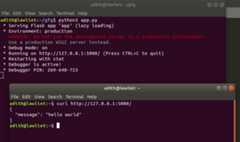Prerequisite:
Introduction to Rest APIREST stands for REpresentational State Transfer and is an architectural style used in modern web development. It defines a set or rules/constraints for a web application to send and receive data. In this article, we will build a REST API in Python using the Flask framework. Flask is a popular micro framework for building web applications. Since it is a micro-framework, it is very easy to use and lacks most of the advanced functionality which is found in a full-fledged framework. Therefore, building a REST API in Flask is very simple.There are two ways of creating a REST API in Flask:
- Using Flask without any external libraries
- Using flask_restful library
Libraries required:
flask_restfulcan be installed via the pip command:
sudo pip3 install flask-restful
Method 1: using only Flask
Here, there are two functions: One function to just return or print the data sent through GET or POST and another function to calculate the square of a number sent through GET request and print it.
python3 1==# Using flask to make an api# import necessary libraries and functionsfromflaskimportFlask,jsonify,request# creating a Flask appapp=Flask(__name__)# on the terminal type: curl http://127.0.0.1:5000/# returns hello world when we use GET.# returns the data that we send when we use POST.@app.route('/',methods=['GET','POST'])defhome():if(request.method=='GET'):data="hello world"returnjsonify({'data':data})# A simple function to calculate the square of a number# the number to be squared is sent in the URL when we use GET# on the terminal type: curl http://127.0.0.1:5000 / home / 10# this returns 100 (square of 10)@app.route('/home/<int:num>',methods=['GET'])defdisp(num):returnjsonify({'data':num**2})# driver functionif__name__=='__main__':app.run(debug=True)
Executing the square function:

Method 2: Using flask-restful
Flask Restful is an extension for Flask that adds support for building REST APIs in Python using Flask as the back-end. It encourages best practices and is very easy to set up. Flask restful is very easy to pick up if you're already familiar with flask.In
flask_restful, the main building block is a resource. Each resource can have several methods associated with it such as GET, POST, PUT, DELETE, etc. for example, there could be a resource that calculates the square of a number whenever a get request is sent to it. Each resource is a class that inherits from the Resource class of flask_restful. Once the resource is created and defined, we can add our custom resource to the api and specify a URL path for that corresponding resource.
python3 1==# using flask_restfulfromflaskimportFlask,jsonify,requestfromflask_restfulimportResource,Api# creating the flask appapp=Flask(__name__)# creating an API objectapi=Api(app)# making a class for a particular resource# the get, post methods correspond to get and post requests# they are automatically mapped by flask_restful.# other methods include put, delete, etc.classHello(Resource):# corresponds to the GET request.# this function is called whenever there# is a GET request for this resourcedefget(self):returnjsonify({'message':'hello world'})# Corresponds to POST requestdefpost(self):data=request.get_json()# status codereturnjsonify({'data':data}),201# another resource to calculate the square of a numberclassSquare(Resource):defget(self,num):returnjsonify({'square':num**2})# adding the defined resources along with their corresponding urlsapi.add_resource(Hello,'/')api.add_resource(Square,'/square/<int:num>')# driver functionif__name__=='__main__':app.run(debug=True)
Explore
Python Fundamentals
Python Data Structures
Advanced Python
Data Science with Python
Web Development with Python
Python Practice